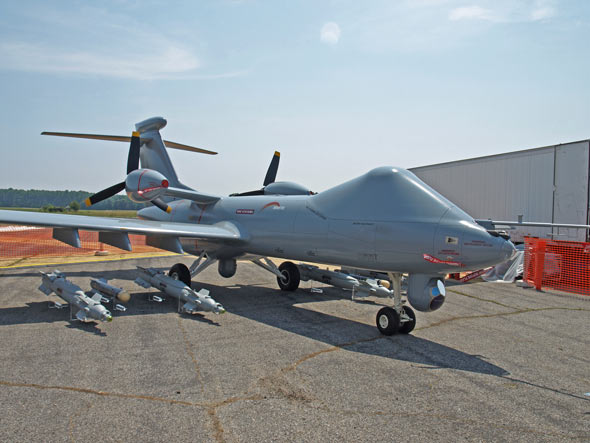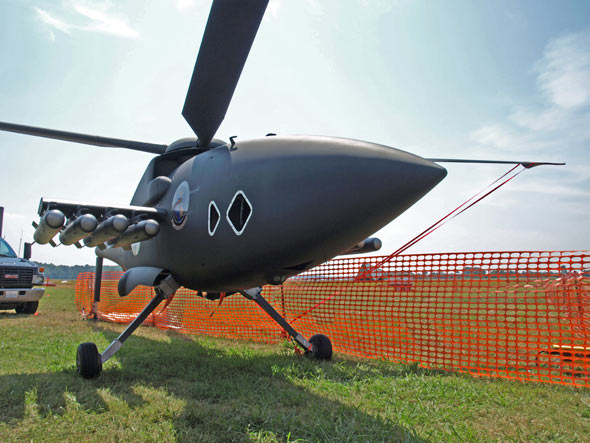
The 5th biennial unmanned systems demonstration hosted by the U.S. Navy PEO U&W and Association of Unmanned Vehicle Systems International (AUVSI) was held 10 August at the Webster Field Maryland, an auxiliary airfield adjacent to U.S. Navy Patuxent River naval air station. Two years ago, Defense Update covered the 4th demonstration held at the same location and our current coverage will relate to the previous event, highlighting the evolution of systems displayed in both events and the trends evident from the current demonstration.
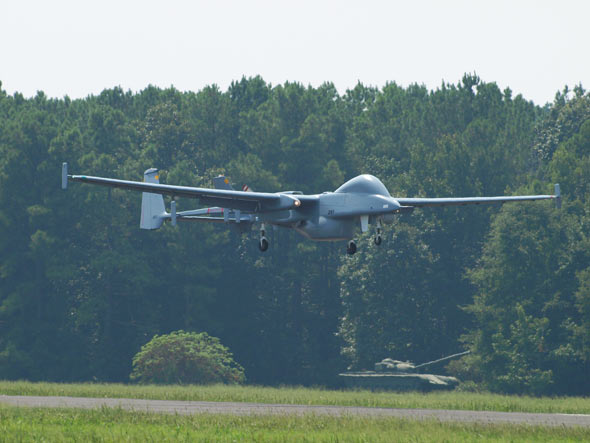
The demonstration focused on advanced multi-platform and manned-unmanned operations, featuring intelligence surveillance reconnaissance (ISR), security, maritime and counter-IED operation. The demonstrations clearly outlined the ability of operators to pursue time critical targets, but such specific actions were not included in the display. Furthermore, the demonstration emphasized different levels of maturity of unmanned aerial and ground systems, whereas aerial systems employed primarily on ISR missions demonstrated impressive functionality and agility. Ground robotic systems still lacking the mobility, flexibility and agility of the human element, are unable to act effectively, as integral part of an assault combat team. At present they are limited primarily to specific high-risk roles, such as handling explosive ordnance and IEDs.

The UVS display was opened by a debut flight of Aurora Flight Sciences’ Goldeneye 80. At a gross take-off weight of 230lb this vertical take-off and landing UAV is part of Aurora’s family of VTOL ducted fan UAV systems, designed under DARPA Organic Aerial Vehicle (OAV) program to facilitate advanced, autonomous operations over rough terrain. Goldeneye can take off from any unprepared surface, including a vehicle flatbed, and is capable of continuously supporting a mission up three hours. In flight, the ducted-fan powered vehicle demonstrated relatively low acoustic signature, compared to past generation tactical UAVs. Nevertheless, unlike the newest small electrical and piston engined UAVs, ducted fan powered vehicles demonstrated here (Goldeneye and T-Hawk) created a distinctive buzzing sound, which should be considered as a significant factor in their ability to operate under clandestine missions.
L-3’s Geneva Aerospace UAV division unveiled the new optionally manned Mobius unmanned aerial system (UAS). The aircraft was flight demonstrated in a manned configuration and, after landing, was quickly converted within minutes into an unmanned aircraft. The Mobius uses a retractable Wescam electro-optic (EO) payload for various ISR missions. As an optionally piloted aircraft it can fly in controlled airspace just like any other aircraft, such as flying to a forward base, from where it can performed manned or unmanned flights. Turning the aircraft into an unmanned platform requires few instruments settings and the replacement of the canopy with low profile fairing improving the aerodynamic flow, contributing to extended mission endurance. Finally, Northrop Grumman demonstrated the FireScout P6, that has recently joined the MQ-4B FireScout test fleet, demonstrating the unmanned helicopter’s potential capabilities for the Army.
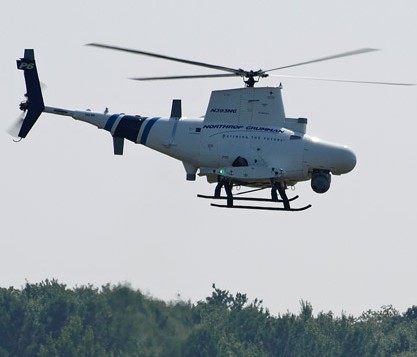
AAI demonstrated here the new Aerosonde 4.7, the new model the company has been developing this year in preparation for the Marine Corps’ small tactical unmanned aerial systems (STUAS) program. The new Aerosonde launched from a newly developed field-deployable launcher is installed, along with the net-retrieving system on a trailer. AAI demonstrated the Aerosonde in a multi-UAV mission, collaborating with two Orbiter UAVs, deployed from an internally transported vehicle (ITV) carrying the Orbiters, their launchers, and ground control segment. After flying their missions, the two Orbiters performed accurate parachute recovery, while the Aerosonde made a skid-landing on the runway. The vehicle can also be retrieved with a network, where lack of clear landing strips require such performance, like landing on abroad ships at sea, or on rugged surface or urban terrain.
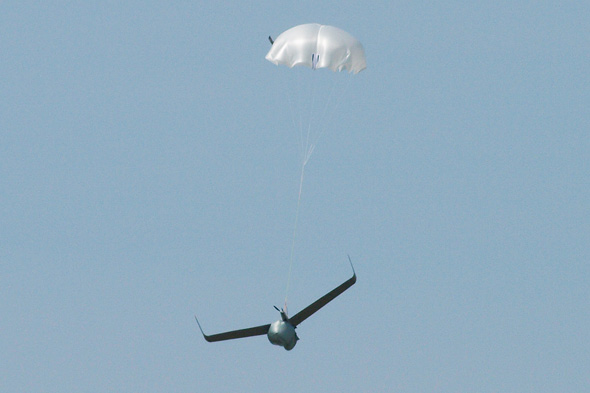
An unmanned aircraft already demonstrating impressive performance in combat operations and maritime missions worldwide, is the IAI Maritime Heron, which also deployed on a successful demonstration, with U.S. Southern command in El-Salvador. The Heron is marketed in the U.S. by IAI’s Stark Aviation subsidiary. The flight display was part of a mission lasting a few hours, where the aircraft was tasked with maritime surveillance, searching an open sea area along the Atlantic coast for drug trafficking boats. For this mission the aircraft carried a multi-sensor package, consisting of a maritime search radar, Multi-mission Optronic Stabilized Payload ( MOSP) 3000 EO turret and provisions for electronic surveillance systems. The suspect boat was located, identified, tracked and then handed over to US Coast Guards. The same target was later tracked by the Scan-Eagle as part of its demonstration. Upon completion of its mission the Heron performed an automatic landing, demonstrating its full mission-autonomous capability.
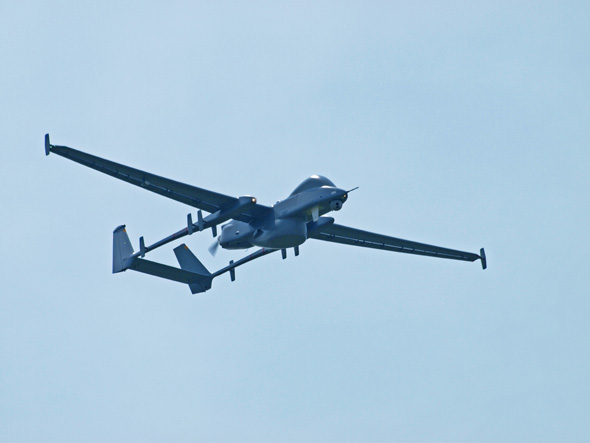
Boeing’s subsidiary InSitu flew the Scan-Eagle and displayed the new, larger Integorator system, being offered by Boeing for the USMC STUAS program. In addition to utilizing its EO camera to follow maritime targets, the Scan Eagle participated in a coordinated mission on land, cooperating with multiple Hornet mini-UAVs. These autonomous miniature helicopters, developed by Adaptive Flight, are utilizing vehicle and ground control systems developed by Georgia Tech. The 2.4 pound helicopters demonstrated IED inspection, by locating suspicious objects in the area, the Hornets covered each other, with one vehicle providing overwatch and the second closing in, to inspect the object, marking it by dropping an with ‘RF tag’, enabling other sensors aand units to monitor and be warned by the potential threat.
Another multi-UVS demonstration involved a simulated route-clearing mission, performed by a team of robots operated by a Stryker vehicle, conforming to a ‘manned-unmanned team’. The robots comprised two of General Dynamics Robotics Systems (GDRS) T-2 vehicles, with tele-operated and autonomous control modes, acting as lead vehicle and a follower patrol vehicle in a convoy, traveling ahead and trailing the manned Stryker, which provided control and supervision of the entire team. The vehicles were tasked with a standard route-clearing mission, scanning the roadside for potential threats and providing early warning of suspected IEDs. The lead T-2 was equipped with GD’s vehicle autonomy control kit, developed for the U.S. Army’s FCS program. The system uses Laser Radar (LADAR) to sense the environment, plot the route of movement, according to the mission, and detect unexpected obstacles, including human activity, to avoid potential risk. Impressive as such performance may be, the level of sophistication of such systems has yet to mature to enable true autonomy operation. At their present state, such systems could become useful as semi-autonomous lead elements, keeping manned vehicles farther from potential threats. However it is still a long way off, until providing the ‘human touch’ will turn these vehicles, from unmanned sitting ducks and operational liability, into a life saving force multiplier, securing convoy and clearing routes in high-risk and complex combat zones.

In another “live” demonstrattion, the team moved through a street safely negotiating human activity. The mission continued to a nearby airstrip where IED were encountered hidden on the scene. More suspicious objects were spotted and an explosive ordnance disposal (EOD) team was dispatched to secure the site and eliminate IEDs. First, the EOD sent in a T-Hawk to scan the area and spot additional threats. Taking off vertically from a nearby site, the T-Hawk swiped the roadside, at low altitude, searching for suspicious objects. As a new suspicious IED site was detected, the T-Hawk operator recorded its location and sent the image and coordinates to the ground robot operator, controlling the iRobot 510 Pacbot. The robot was offloaded by hand from the team‘s HMMWV, and dashed to the scene to eliminate the IED by attaching a small C4 explosive charge to neutralize it in place. The whole process continued with the Scan Eagle, flying overhead securing the scene and T-Hawk providing a closer peripheral view of the site for the ground EOD team.
A different scenario involved manned-unmanned, air and ground operation of the Aerovironment Puma-AE and iRobot Warrior and Pacbot UGVs. The Puma was launched into flying an extended patrol of over one hour. This UAV, considered to replace some of the Raven Small Unmanned Aerial Systems, currently used by different US services, is the most advanced mini-UAV developed by AV. Featuring a new, retractable stabilized EO payload and the capability to fly missions up to two hours. It already demonstrated mission endurance beyond six hours, using new Proton exchange membrane (PEM) Hydrogen fuel cells.
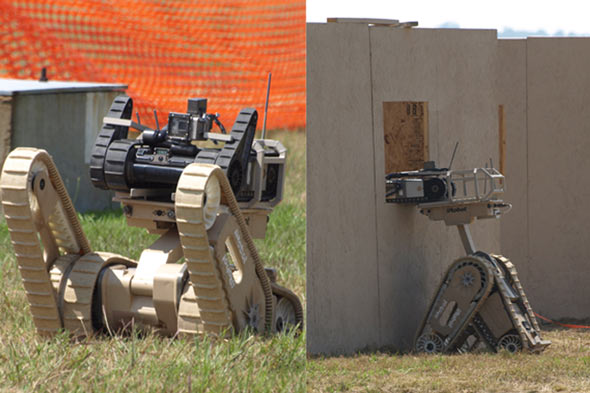
On the mission demonstrated at Webster field, the Puma provided area security, spotting intruders in an urban area, while the UAV maintained constant watch of the intruder’s location until a team of guards, assisted by a Warrior unmanned ground vehicle (UGV) arrived at the scene.
The Warrior was employed in a ‘marsupial configuration’ carrying a Pacbot on its cargo bed. As the Warrior approached the site it used its flippers to erect and peek through the window, inserting the smaller Pacbot through the opening, to survey the interior space for hostiles. Once the team obtained the information from inside the house, the heavier Warrior was used to breech the door and lead in the final assault. While the ground robots demonstrated impressive capabilities in the mission preparation phase, providing important intelligence that cannot be obtained by other means without putting human lives at risk, it was clear that in the actual combat phase, when rapid movement, timing and coordination are imperative, ground robots are still reacting too slow and may actually become a burden to the assault team. Military experts agree that robots have still a long way to go before they can act as an integral part of the urban combat team.
